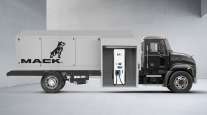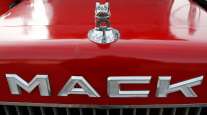Mack Trucks Touts 2010 Engine Advances, Progress on Development of Hybrids
This story appears in the March 8 print edition of Transport Topics.
Mack Trucks executives said they are pleased with the functioning of their new 2010 selective catalytic reduction engines and will market the attributes of the power plants as the truck maker tries to regain sales volumes and market share through 2011.
Two executives for the original equipment manufacturer told Transport Topics editors and reporters on Feb. 23 that the company needs to see a recovery in its core markets of construction and refuse vehicles and less-than-truckload transportation.
They also said Mack is working mainly on diesel-electric hybrids but also will consider the diesel-hydraulic variety, and that if the right opportunity presents itself the bulldog-brand OEM will enter the Class 5-7 medium-duty market.
“We see some improvement on truck volumes in ’10, but will it be 10% or 20%? It’s difficult to say now,” said Mack Senior Vice President Kevin Flaherty.
As a whole, North American truck makers have experienced a 66.5% decline in sales since the banner year of 2006, plunging from 284,000 Class 8 U.S. tractors to fewer than 95,000 last year. In that plunge, Mack’s market share retreated to 8% last year from 10.4% in 2006.
Flaherty said that the sales volume of Class 8 straight trucks fell 75%. These vehicles are at the core of Mack’s business: large concrete mixers, concrete pumpers, dump trucks and refuse trucks.
While some federal stimulus spending has gone into road work, Flaherty said his customers report that it has been for more modest repaving jobs rather than massive highway improvements or additions.
“Concrete is still pretty bloody,” he said.
Adding to the woes in Mack’s market segments, refuse haulers have become more efficient in vehicle usage, leading to fewer truck purchases.
Flaherty and David McKenna, Mack’s director of powertrain sales, said Mack’s new engines, required by tighter federal emissions standards, offer practical benefits as well as lower emissions.
McKenna said that Mack went through a two-month process starting in October to alter both its engine plant in Hagerstown, Md., and its truck plant in Macungie, Pa., as the new engines changed the truck assembly process. While conventional Mack tractors are completed at Macungie, the mixers, dumps and trash trucks are typically finished by body builders.
“We had body-builder clinics on the new trucks. We needed the buy-in of about 100 body builders that we partner with,” McKenna said. In the new configurations, Mack was able to actually gain one inch of available space behind the cab, he said, and the body builders regarded that as a huge improvement.
Mack said the new engines will get about 5% better fuel economy than the 2007-09 generation of engines, require less active regeneration of diesel particulate filters and run cooler than last year’s models.
With SCR virtually eliminating nitrogen oxide emissions in the exhaust system, McKenna said the engines’ rate of exhaust gas recirculation would be closer to the 2002-06 generation of engines rather than the 2007-09 batch, making the new models more efficient.
As pressure to reduce carbon dioxide emissions grows, Flaherty and McKenna said parent corporation Volvo AB continues to pursue alternative fuels such as compressed or liquefied natural gas and less familiar substances such as di-methyl ether and biogas.
McKenna said the corporation prefers diesel-electric hybrid engines to diesel-hydraulic because diesel-electric can provide “key-off” applications through stored battery power when the diesel engine is turned off. However, he also said the company cannot ignore hydraulic power, as engineers, including those from Eaton Corp., have argued that hydraulic hybrids are particularly beneficial for refuse vehicles.
Flaherty and McKenna said hybrids currently have a number of problems, such as high costs, low levels of production and batteries that are less than ideal.
“The question is, how to get the appropriate mass of production? I think the technology will continue to need state or federal subsidies,” Flaherty said.
McKenna said the demand for hybrids correlates very well with the price of diesel fuel.
“At $4 a gallon, people get religion, and at $4.50 it’s: ‘Hallelujah, I’ve found God,’ ” he said.
As for medium-duty trucks, Volvo AB has the smallest presence in that market of any North American manufacturer of heavy-duty trucks. Daimler Trucks and Navistar Inc. have substantial activity in the lower weight classes, and Paccar Inc. is expanding, too.
Nissan Diesel is owned by Volvo AB but sold just 888 Class 4-7 vehicles in the United States last year, whereas VTNA and Mack are purely Class 8 manufacturers.
“We continue to look at the right approach for the Class 5, 6 and 7 business and have looked at a lot of scenarios but haven’t moved forward yet. But we will continue to look,” Flaherty said.




